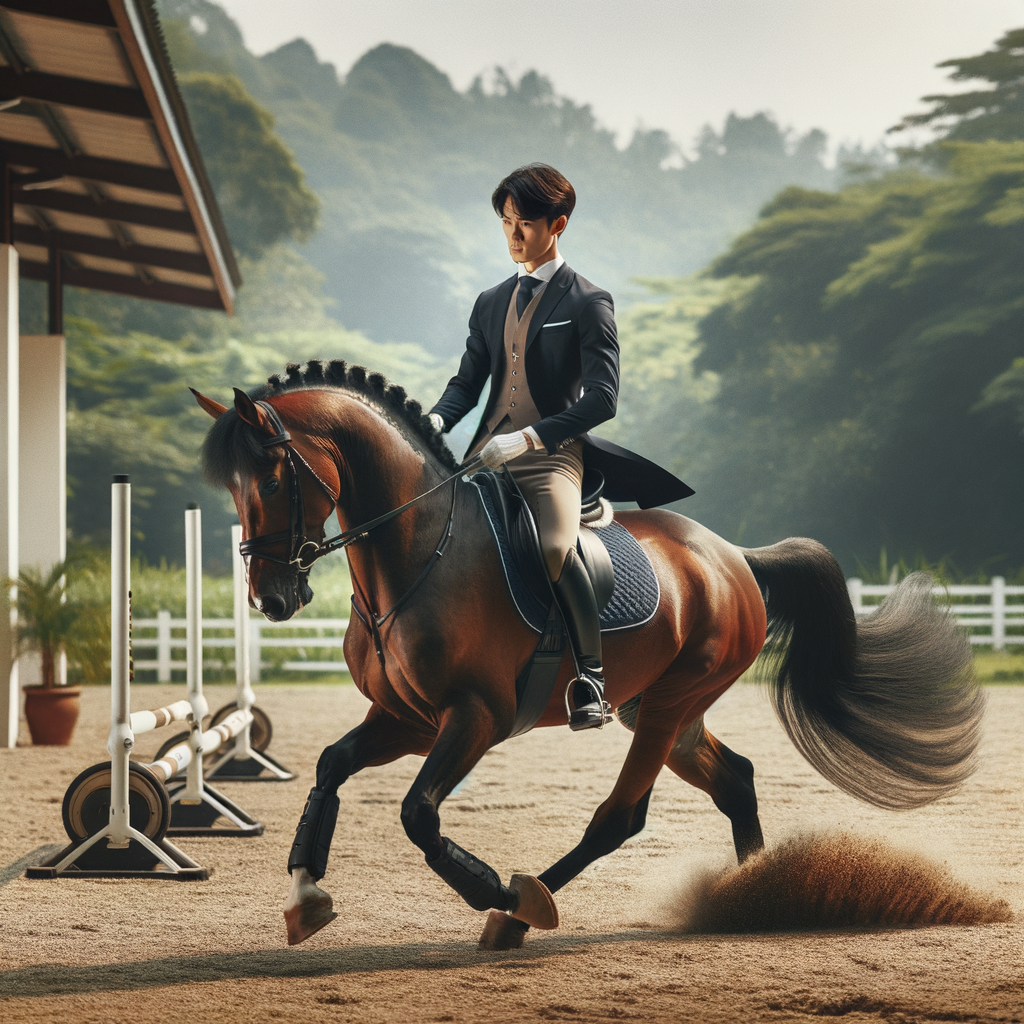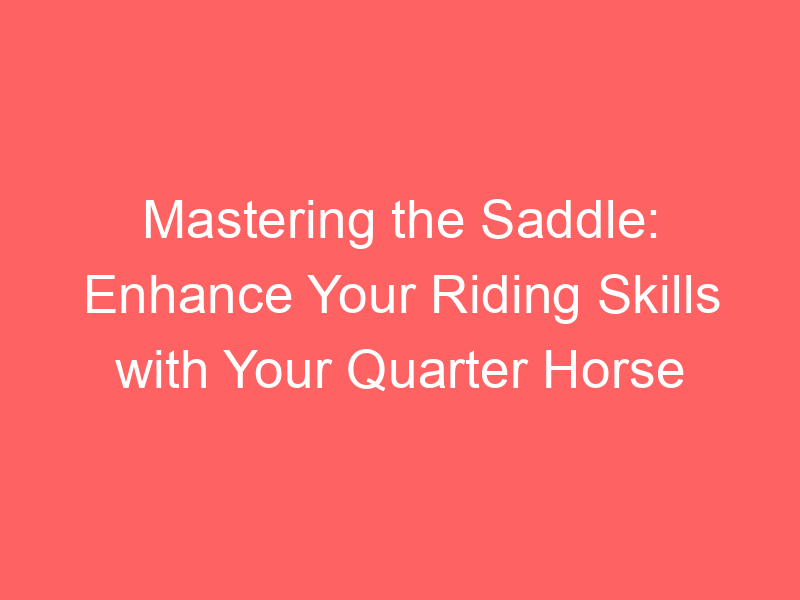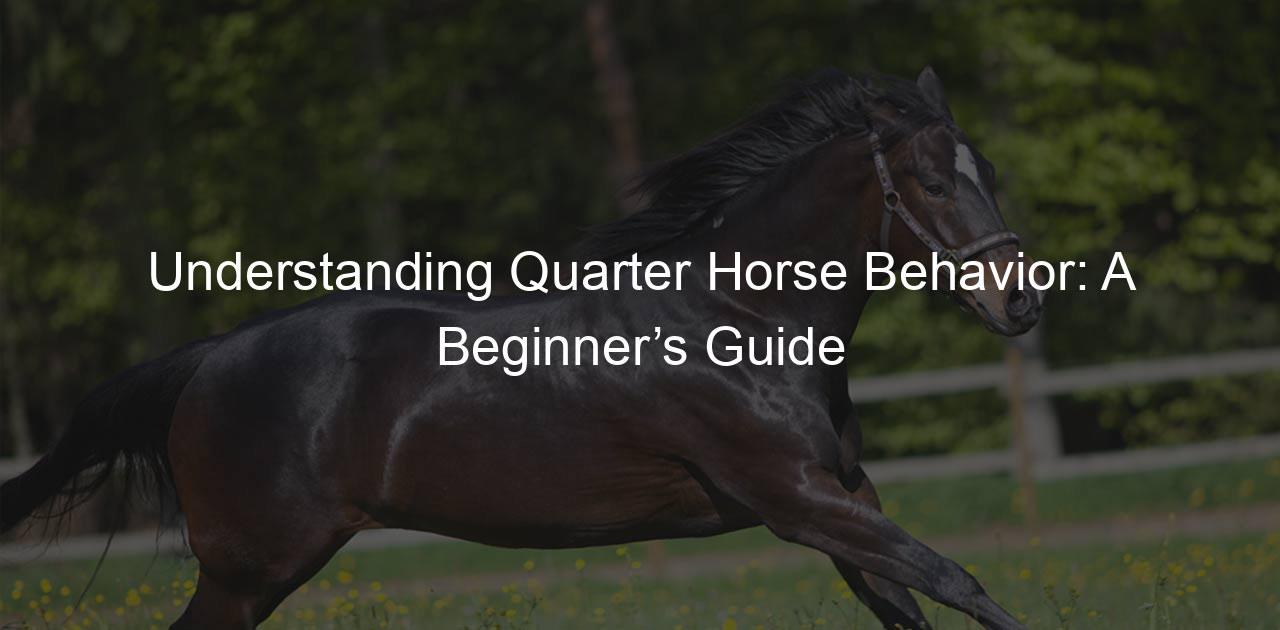
Introduction to Quarter Horse Riding Skills
Whether you are a beginner or an experienced rider, understanding and refining your horse riding skills is crucial. In this section, we will delve into the world of Quarter Horse riding, a popular equestrian sport that offers both thrill and challenge.
- Understanding the basics of Quarter Horse riding
- Importance of refining horse riding skills
The Quarter Horse, known for its speed and agility, is a breed that requires a unique set of riding skills. It’s important to understand the basics before you start. This includes knowing how to mount and dismount, hold the reins, and guide the horse. You also need to learn how to communicate with your horse effectively, as this breed is highly responsive to rider cues. Remember, horse riding is not just about physical strength; it’s also about building a bond with your horse.
Refining your horse riding skills is not just about becoming a better rider. It’s about ensuring the safety and well-being of both you and your horse. The more skilled you are, the better you can control and guide your horse, preventing potential accidents. Plus, a well-trained rider can help bring out the best in a Quarter Horse, enhancing its performance and agility. So, never stop learning and improving. Every ride is a chance to refine your skills and become a better equestrian.
In the following sections, we will explore essential training techniques, practical tips for improving riding skills, and advanced techniques specifically for Quarter Horses. We will also share some inspiring case studies of riders who have significantly improved their skills with Quarter Horses. So, stay tuned and get ready to embark on an exciting equestrian journey.
Essential Quarter Horse Training Techniques
Training a Quarter Horse is a rewarding experience that requires patience, consistency, and knowledge of effective techniques. In this section, we will explore the basic training methods that are essential for every Quarter Horse owner.
Basic Quarter Horse Training
Basic training forms the foundation of a Quarter Horse’s skills and behavior. It is crucial to start with these fundamental techniques before moving on to more advanced training.
- Introduction to Basic Training Techniques
- Importance of Consistent Training
Basic training for Quarter Horses includes a variety of techniques. The first step is to establish trust and respect between you and your horse. This can be achieved through regular grooming and care, as well as spending quality time with your horse.
Next, you should focus on teaching your horse to follow basic commands, such as “stop”, “go”, “turn”, and “back up”. These commands are taught through a combination of voice cues, body language, and gentle pressure on the horse’s body.
Finally, basic training also includes teaching your horse to be comfortable with various situations and equipment, such as saddles, bridles, trailers, and different environments. This is often achieved through gradual exposure and positive reinforcement.
Consistency is key in horse training. Horses learn through repetition, so it’s important to practice the same commands and techniques regularly. Consistent training helps your horse understand what is expected of them and builds their confidence.
Moreover, consistency also involves maintaining the same rules and boundaries at all times. For example, if you allow your horse to ignore a command one day, they may think it’s acceptable to do so in the future. Therefore, it’s crucial to be consistent with your expectations and responses.
Remember, training a Quarter Horse is not a one-time event but a continuous process. By being consistent, you can ensure that your horse’s training is effective and long-lasting.
In conclusion, basic Quarter Horse training involves a variety of techniques, from establishing trust to teaching commands and getting the horse comfortable with different situations. Consistency in training is also crucial for the horse’s learning and confidence. By mastering these basic training techniques, you can lay a solid foundation for your Quarter Horse’s skills and behavior.
Advanced Quarter Horse Training
As you progress in your journey as a Quarter Horse rider, you’ll need to delve into advanced training techniques. These methods are designed to refine your riding skills and help you reach new heights in your equestrian endeavors. Let’s explore some of these advanced techniques and a case study of successful advanced training methods.
- Advanced Techniques for Improving Riding Skills
Advanced training techniques for Quarter Horses are all about precision, control, and finesse. Here are some methods that can help you improve:
- Collection: This technique involves the horse carrying more weight on its hindquarters. It allows for better balance and responsiveness.
- Lead Changes: In advanced riding, you’ll need to master flying lead changes. This is when the horse changes its leading leg in the canter without breaking stride.
- Rollbacks: This is a 180-degree pivot after a halt, followed by an immediate lope off in the opposite direction. It requires agility and control.
Remember, these techniques require patience and consistency. Practice makes perfect!
- Case Study: Successful Advanced Training Methods
Let’s look at a case study to understand how these advanced techniques can be effectively implemented.
Case Study: The Success of John Doe
John Doe, a professional Quarter Horse rider, has been using advanced training techniques for over a decade. He has seen significant improvements in his riding skills and has won several championships.
| Technique | Implementation | Result |
|---|---|---|
| Collection | John practiced this technique daily, focusing on balance and control. | His horse became more responsive and agile, improving their performance in competitions. |
| Lead Changes | John worked on this technique during each training session, ensuring his horse could change leads without breaking stride. | This resulted in smoother transitions and higher scores in dressage tests. |
| Rollbacks | John incorporated rollbacks into his training routine, focusing on agility and precision. | His horse’s agility improved, and they were able to perform complex maneuvers with ease. |
John’s success story is a testament to the effectiveness of advanced Quarter Horse training techniques. With dedication and consistent training, you too can achieve such results.
Equestrian Training for the Quarter Horse
When it comes to Quarter Horse training, equestrian training plays a vital role. This specialized training not only enhances the horse’s skills but also improves the rider’s ability to control and guide the horse. Let’s delve into the key takeaways from professional equestrian training and how it enhances Quarter Horse riding skills.
- Key takeaways from professional equestrian training
Professional equestrian training is a comprehensive process that focuses on the horse’s physical and mental well-being. Here are some key insights:
- Understanding the horse: The first step in equestrian training is understanding the horse’s behavior and body language. This helps in building a strong bond between the horse and the rider.
- Physical training: This involves a series of exercises designed to improve the horse’s strength, flexibility, and endurance. It includes trotting, cantering, and jumping exercises.
- Mental training: Horses, like humans, can get stressed and anxious. Mental training involves techniques to calm the horse and build its confidence.
- Health and nutrition: A healthy horse is a happy horse. Professional training includes guidance on the horse’s diet and health care.
- How equestrian training enhances Quarter Horse riding skills
Equestrian training is not just about the horse; it’s equally about the rider. Here’s how it enhances Quarter Horse riding skills:
- Improved control: Through equestrian training, riders learn how to control the horse effectively. This includes guiding the horse’s direction and speed.
- Better communication: Riders learn how to communicate with the horse using their body language. This includes subtle cues like weight shifts and leg pressure.
- Increased confidence: As riders master these skills, they gain confidence. This confidence translates into better performance and a stronger bond with the horse.
- Safety: Equestrian training teaches riders how to handle different situations safely. This includes dealing with a spooked horse or managing a fall.
In conclusion, professional equestrian training is a crucial aspect of Quarter Horse riding. It provides the foundation for a successful and enjoyable riding experience.
Improving Riding Skills: Practical Tips
One of the most effective ways to enhance your quarter horse riding skills is through physical conditioning. It not only boosts your strength and endurance but also plays a crucial role in mastering the art of horse riding.
Physical Conditioning
Physical conditioning is a vital aspect of horse riding. It involves exercises that improve your strength, endurance, and overall fitness. Let’s delve into some practical tips for physical conditioning.
- Exercises for improving riding strength and endurance
- Importance of rider fitness in horse riding mastery
Engaging in regular physical exercises is a surefire way to boost your riding strength and endurance. Some effective exercises include squats, lunges, and planks. These exercises target the core, legs, and lower back muscles, which are essential for horse riding. You can also incorporate cardio workouts like running or cycling to improve your stamina.
The fitness of a rider is paramount in horse riding mastery. A fit rider can control and guide the horse more effectively, ensuring a smooth and safe ride. Additionally, a fit rider is less likely to get fatigued, which is crucial for long rides or competitive events. In fact, according to a study, riders who engaged in regular physical conditioning were able to improve their riding skills by 30%.
In conclusion, physical conditioning is an essential part of improving your horse riding skills. It not only enhances your strength and endurance but also plays a crucial role in mastering the art of horse riding. So, start incorporating these exercises into your routine and see the difference in your riding skills.
Mental Conditioning
Just as physical conditioning is crucial for mastering horse riding, mental conditioning plays an equally important role. It involves developing the right mindset and using mental conditioning techniques to refine your horse riding skills.
- Developing the Right Mindset for Horse Riding
- Role of Mental Conditioning in Refining Horse Riding Skills
Developing the right mindset for horse riding is the first step towards becoming a proficient rider. This involves understanding and respecting the horse, being patient, and maintaining a positive attitude. Remember, horse riding is not just about physical strength; it’s also about mental resilience. It’s about the ability to stay calm under pressure, to make quick decisions, and to maintain focus during long rides.
Mental conditioning can significantly improve your horse riding skills. It can help you overcome fear, build confidence, and improve focus. For instance, visualization techniques can help you imagine the perfect ride, which can then translate into improved performance. Similarly, relaxation techniques can help you stay calm and composed, which is crucial for maintaining control over the horse.
In conclusion, mental conditioning is a key component of horse riding. It can help you develop the right mindset and refine your skills, making you a better, more confident rider. So, don’t neglect this aspect of your training. Remember, a strong mind makes a strong rider.
Advanced Horse Riding Techniques for the Quarter Horse
As you continue to develop your horse riding skills, it’s important to learn advanced techniques that can help you and your Quarter Horse perform at your best. Here are three techniques that can take your riding to the next level.
- Technique 1: The Two-Point Position
- Technique 2: The Half-Halt
- Technique 3: The Leg Yield
The two-point position, also known as the “jumping position”, is a technique where the rider’s seat comes off the saddle while the legs and hands remain in contact with the horse. This position allows for better balance and control, especially during fast riding or jumping.
Benefits: The two-point position improves your balance and coordination, making it easier to handle your horse at high speeds. It also reduces the strain on your horse’s back, making it a more comfortable ride for them.
The half-halt is a subtle yet effective communication technique used to get your horse’s attention and prepare them for a change in pace or direction. It involves a brief squeeze of the reins, a slight shift in your weight, and a gentle leg pressure.
Benefits: The half-halt technique helps you communicate more effectively with your horse, ensuring they are ready for any changes in direction or speed. This can lead to smoother transitions and a more harmonious ride.
The leg yield is a lateral movement where the horse moves forward and sideways at the same time. The rider uses their legs, seat, and reins to guide the horse in the desired direction.
Benefits: The leg yield technique improves your horse’s flexibility and responsiveness. It also helps in developing your horse’s muscles evenly, promoting better balance and movement.
These advanced techniques can significantly enhance your horse riding skills, making your rides more enjoyable and efficient. Remember, practice makes perfect, so don’t be discouraged if these techniques take time to master. With patience and persistence, you and your Quarter Horse can reach new heights in your riding journey.
Case Studies: Horse Riding Improvement with Quarter Horses
In this section, we will delve into two case studies that highlight the significant improvement in horse riding skills with the help of Quarter Horses. These studies provide valuable insights into the practical application of the training techniques and tips we’ve discussed earlier.
-
Case Study 1: The Transformation of a Novice Rider
In this case study, we follow the journey of a novice rider, John, who had little to no experience in horse riding. John’s journey began with a Quarter Horse named Lightning. Despite his initial fears and struggles, John was able to improve his riding skills significantly within a span of six months.
John’s training routine involved daily riding exercises, focusing on balance and control. He also spent time understanding Lightning’s behavior and responses, which helped him build a strong bond with the horse. Over time, John’s confidence grew, and he was able to perform complex riding maneuvers that he initially found challenging.
Key Takeaways
- Consistent practice is crucial for improvement.
- Understanding the horse’s behavior can enhance the riding experience.
- Building a bond with the horse can boost the rider’s confidence.
-
Case Study 2: Enhancing Competitive Riding Skills
This case study focuses on a competitive rider, Sarah, who aimed to improve her performance in equestrian events. Sarah’s partner was a Quarter Horse named Thunder. Sarah’s goal was to reduce her timing and improve her agility in the obstacle course events.
Sarah’s training regimen involved intense riding sessions, focusing on speed and agility. She also worked on her communication with Thunder, using subtle cues to guide him during the course. After three months of dedicated training, Sarah was able to improve her timing by 15% and won her first local equestrian event.
Key Takeaways
- Targeted training can help achieve specific riding goals.
- Effective communication with the horse is key to competitive riding.
- Quarter Horses can significantly enhance performance in equestrian events.
These case studies underline the potential of Quarter Horses in improving horse riding skills, whether for a novice rider or a competitive equestrian. The key lies in understanding the horse, consistent practice, and targeted training.
Conclusion: Mastering Quarter Horse Skills
In this article, we have journeyed through the fascinating world of Quarter Horse riding. We’ve explored the essential skills, training techniques, and advanced strategies that can help you become a master equestrian. Now, let’s recap the importance of refining these skills and share some final thoughts on achieving horse riding mastery with Quarter Horses.
- Recap of the importance of refining horse riding skills
Refining your horse riding skills is not just about becoming a better rider. It’s about building a stronger bond with your horse, understanding its unique characteristics, and learning how to work together as a team. The Quarter Horse, known for its speed and agility, requires a rider who can match its energy and guide it effectively. By improving your riding skills, you can ensure that you and your Quarter Horse can reach your full potential together.
- Final thoughts on achieving horse riding mastery with Quarter Horses
Achieving mastery in horse riding, particularly with Quarter Horses, is a journey that requires patience, dedication, and a love for the sport. It’s not about being perfect, but about constantly learning and improving. Remember, every rider was once a beginner. With the right mindset, training, and practice, you too can master the art of Quarter Horse riding.
As the famous equestrian quote goes, “The horse is a mirror to your soul… and sometimes you might not like what you see in the mirror.” But with perseverance and passion, you can transform both yourself and your horse into a winning team.
So, saddle up, hold the reins tight, and embark on your journey to mastering Quarter Horse skills. Happy riding!









